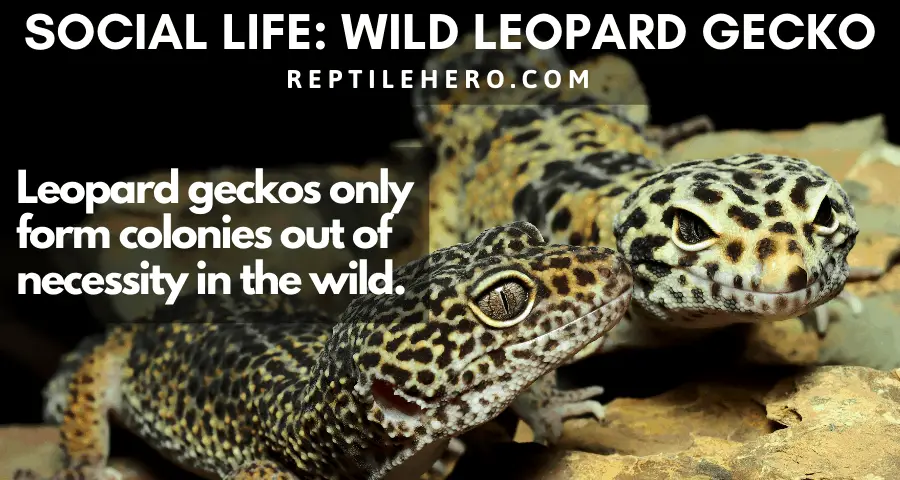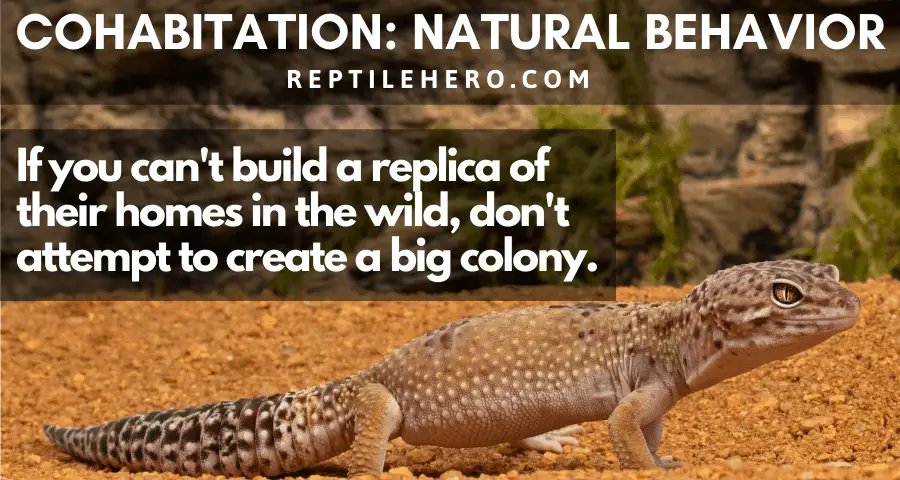Housing Male and Female (or Same Sex) Leopard Gecko Together? Final Guide
Once you get your first leopard gecko, or any other reptile for that matter, you will soon find yourself hooked – always looking for new members you can welcome into the family. Then you might start considering housing them together in pairs or groups, but the question is: should you?
Generally, the cohabitation of a male and female leopard gecko should be avoided. The same applies to geckos of the same sex. Even when done carefully, long-term leopard gecko cohabitation can lead to aggressive behavior that can result in serious injuries and even death of the animal.
Considering having your leopard geckos share a vivarium? Read this first!
The Science Behind Leopard Gecko Cohabitation
The more the merrier? In the case of leopard geckos kept as part of the family, the answer is more complicated than you might think. Especially because the community has only existed for a few decades, advances in husbandry have only been made in recent years, and even researchers don’t know every single thing there is to know about leopard geckos.
Social Life and Behavior
Much is still unknown and uncertain when it comes to the natural living conditions of the familiar leopard gecko. Because of this, there are still a lot of disagreements between different groups of keepers and breeders when it comes to properly housing them in captivity. In fact, many still strongly push for the practice of housing a single adult in a 10-gallon vivarium. So you can imagine how many misconceptions there still are about cohabitation.
When in the Wilderness
Like many other cold-blooded reptiles, leopard geckos are ordinarily solitary in nature but they are willing to congregate if it is beneficial to do so. Leopard geckos have been documented to aggregate whenever it will help them survive despite their harsh living conditions in the wild.
Many people seem to still have the misconception that wild leopard geckos naturally live in sandy deserts that are virtually devoid of any vegetation, water, and insects. Often, these people are new to the reptile-keeping community. After researching, you will realize that these little critters actually prefer taking shelter within the crevices of rock outcroppings one would find in semi-arid grasslands [1]. They could also dwell in hollowed-out tree trunks and thick branches as well as holes of man-made structures in the more urbanized areas.
In these formations, leopard geckos are able to get away from the hot sun and dry air. But since such refuge sights are usually few and far between, these soft-scaled animals have pretty much no choice but to share the available safe haven in the area when the morning star is still out and about.
However, you won’t really see them huddled around each other or in distinct family groups. Within a colony, individuals, smaller all-female groups, and harems will occupy different chambers and passages accessible to them below the ground or in a rock outcropping.

Why do leopard geckos live in colonies in the wild?
There are 5 main reasons why wild leopard geckos live in loose colonies:
- Breeding season has begun.
- Insects and other small prey items are teeming in the area.
- In preparation for brumation during the winter season.
- There is a lack of other shelter options.
- Simply due to their large population in the vicinity.
The profile of the loose colonies of wild leopard geckos varies depending on the season. When taking shelter from the increasingly cold and dry air of fall and winter, they group together regardless of their age and sex. Once the breeding season starts though, males become more aggressive towards other males that could become competition when it comes to mating. Then after the hatchlings emerge from their soft-shelled elongated eggs, these young geckos will dominate the space for a period of time.
However, we have yet to find a significant amount of field studies that discuss their social behavior in great detail throughout their lifetime. This also includes topics on hierarchy within colonies, as well as all the aspects which contribute to peaceful and successful cohabitation, among many other things.
When Kept in Captivity
Pet leopard geckos are commonly kept individually as many other keepers have faced dire consequences from improper and ill-formed cohabitation practices. Conversely, only a few and experienced keepers and breeders have been successful in their attempts of housing leopard geckos in the same vivarium.
Since the total picture of cohabitation in wild leopard geckos is still far from clear and complete, it is to be expected that most pet parents are still apprehensive in housing two or more leos in a single vivarium. That said, most stories of leopard gecko cohabitation do not have a happy ending.
The main factors that could explain the behavioral differences between captive-bred and wild leopard geckos in cohabitation are the lack of 1) space and 2) freedom. Unlike the untamed populations in Western Asia and the Middle East, pet leopard geckos are unable to easily get out of their tanks and explore in open spaces. Furthermore, they are not free to roam about as they wish unless their keeper decides to take them out of their enclosure.
This may also be why leopard geckos are more prone to being hostile to their tank mates. I mean, just imagine yourself in the same situation. You probably won’t enjoy being locked up in a small room with someone you don’t even know well for the rest of your life.
As such, hobbyists have only been able to accomplish relatively problem-free leopard gecko cohabitation when they provide their animals with more than enough space for rest and exploration within their cage. Even then, housing multiple geckos together come with its challenges. What’s more, is that seemingly compatible leopard geckos housed together for years – even decades – may suddenly regard each other with great hostility without any apparent rhyme or reason.
The majority of experts advise against the cohabitation of pet leopard geckos because the primary factors that bring about aggregation among their wild counterparts – with the exemption of breeding – can easily be resolved through proper husbandry.
Now, whether or not these animals will mellow out and become friendly towards their conspecifics after many more years of being in the care of humans like dogs and cats, I don’t have the answer. Only time will tell.
So Can You Cohabit Leopard Geckos of the Opposite Sex?
The cohabitation of a male leopard gecko with a female leopard gecko is only recommended for keepers who are well-versed in advanced husbandry and are planning to pursue a professional career in breeding.
Even when cohabiting leopard geckos is done to improve fertility rates during breeding, there are still many factors one must consider. As a rule, never house geckos with a massive age and size difference in the same tank, regardless of its total internal capacity. Housing them together leads to bullying and severe health concerns.
Younger, smaller, and weaker leopard geckos are at high risk of experiencing stress, being attacked, dropping its tail, and, in the worst-case scenario, dying as it is more vulnerable. It is also crucial to note that not all females will react positively toward a male when introduced to each other, even if both of them are already sexually mature enough to get paired up. They may respond to unwanted courting advances by biting to cause injury or throwing off the male attempting to mount them.
A leopard gecko that hatches as females even when exposed to high incubation temperatures designed for males, also known as a “hot female,” normally has elevated levels of androgen but low levels of estrogen. They are not sexually receptive – unresponsive to potential mates and unable to produce and lay eggs. Such geckos typically act like males and are incredibly aggressive [2].
Permanently housing the male leopard gecko with a single female also increases the likelihood of overbreeding. Numerous breeders have reported that this normally causes life-threatening health issues for the female. Due to this, experts recommend breeders to form harems of one male and two or more females instead of pairs. But keeping track of multiple adult geckos in one enclosure comes with its own set of challenges and problems as well.
5 Most Common Reasons Why Owners Consider Cohabitation
Considering the lack of up-to-date credible scientific documentation of long-term social aggregation and behavior of wild and captive-bred leopard geckos, why do some people push through with the practice of cohabitation? Well, a couple come to mind.

Keepers attempt to house multiple leopard geckos in the same enclosure for one or more of the following 5 reasons.
#1 – Saves Resource
New leopard gecko owners have the impression that housing leopard geckos together will save them money and space. Unfortunately, such thinking mostly stems from outdated reptile-care standards which do not allow for animals to thrive in captivity, ones that would wrongly recommend minimalistic small-scale enclosure set-ups.
Sure, if you house a pair or a small group of leopard geckos in one enclosure, you will definitely save some space and money since you will only need one enclosure. However, with every additional gecko, the minimum floor space and total capacity your enclosure should have will also increase accordingly.
Then you also have to think about additional heating and lighting fixtures, hides, and other provisions for each of your geckos. All of that racks up a considerable sum. So whatever savings you think you will save in the beginning might simply end up costing you more or less the same expenses if you were to simply separate them.
Plus, it will be harder to tell which one of them is sick if they are all housed together since it will be harder to tell which poop is whose. Even worse, if one has a hard-to-detected transmissible disease, every single one of them may get infected and severely sick before you notice anything wrong.
#2 – Takes Less Time
Depending on an individual owner’s specific circumstances, this may or may not be true. In terms of cleaning and general vivarium upkeep, having fewer enclosures to maintain will save you time.
Nonetheless, making sure that every single leopard is getting enough food and water or that not a single one is getting bullied by another can be incredibly time-consuming. Moreover, if you think that taking care of multiple individually housed leopard geckos would take too much from your free time, please reconsider your plans of getting more than a single one.
Although geckos are fairly easy to look after, they do need to be monitored from time to time to ensure that they are strong and healthy. With cohabitation, you will also have to look out for signs of aggression and domination. If you don’t have time to spare for that, I would advise you not to bite off more than you can chew.
#3 – To Provide Company
Some pet parents think that their leopard gecko gets lonely so they buy and/or adopt another one. Others also argue that cohabitation provides social stimulation for these animals.
However, there is little evidence that substantiates such claims. It is also important to keep in mind that leopard geckos, like many other reptiles, are innately solitary creatures. They are not capable of forming strong loving bonds with others or being affectionate in the same way our furry friends can.
In fact, the opposite is true. Being in close proximity with a potential rival for an extended period will only stress them out.
#4 – Encourages Natural Behaviors
It is difficult to observe how leopard geckos normally act in their natural habitats unless they are out to hunt for food when it is dusk or dawn. During such times when it’s not too bright but also not too dark out in the open, they can go out with less risk of getting spotted by potential predators.
But this also means that it is harder for researchers to closely observe them and get a clear picture of how they would normally act in groups at their chosen refuge sites without being intrusive. As such, it does make sense to recreate their homes to make this easier.

Admittedly though, attempting to do that would require a lot of land and other resources. So unless you have a massive patch of land with enough space to simulate their native homes in order to trick them into thinking they are living in the wilderness, as well as a ton of other resources (e.g. source of power, food, etc.), I would advise against housing colonies of leopard geckos for such a purpose.
A much cheaper and more feasible option for encouraging your leopard gecko to engage in healthy natural behaviors such as burrowing and rock-climbing is to simply provide him or her with a naturalistic or bioactive tank set-up.
#5 – For Breeding Projects
Last but not the least, keepers start considering cohabitation once they learn about the different morphs available in the market along with the possibility of creating a new rare morph.
Without extensive experience in caring for multiple leopard geckos – housed individually – of different ages, sexes, and temperaments, I wouldn’t advise pet parents to try their hands in breeding. A lot of things could go wrong if you go about it without careful planning and technical know-how.
Once breeding is successful, you will have to take care of a lot of eggs during incubation and when they hatch you will have to look after a maximum of 16 hatchlings from a single breeding season. You will need to dedicate a significant amount of your time, space, and resources in keeping so many leopard geckos.
So if you are not ready to take on such responsibility, let your geckos live out their lives as happy bachelors and bachelorettes.
Can Same-Sex Leopard Geckos Live Together?
Male leopard geckos should never be permanently housed together because they will instinctively behave aggressively towards one another. Conversely, female leopard geckos can be kept in the same vivarium provided that it is generously sized and each is given their own set of provisions.
Though normally docile animals, leopard geckos can be incredibly hostile to their conspecifics. Such antagonistic tendencies are even more evident between males during the breeding season. As a matter of fact, male leopard geckos seem to have developed such a strongly hostile response to unfamiliar geckos due to the difficulty of detecting rival males from a distance using their sense of sight alone [3].
Male leopard geckos are able to distinguish males from females through the smell of their pheromones because of the specific chemicals found in their skin – fatty acids to be more specific [4]. Males possess cholestanol, stigmasterol, and stigmastanol. On the other hand, females possess a series of long-chain saturated and monounsaturated methyl ketones.
During shedding, the old skin still stuck on their bodies may act as a barrier and cause misidentification. As a result, a highly territorial male leopard gecko may attack a female that has yet to finish shedding. Leopard geckos should never be introduced to others that are still in the process of getting the dead skin off their bodies.
Most keepers recommend cohabitation only when both leopard geckos are female since they are a lot less combative. The exact factors behind why females are more tolerant and/or apathetic of others living near them or sharing the enclosure are still unclear.
It does seem that there are a lot less instances of fighting and bullying between females of comparable size and age. But saying this also doesn’t erase the fact that it can happen. Don’t believe me? Then watch this:
Furthermore, hot females react to both males and females with great hostility so they should never be housed together with other leopard geckos regardless of the potential tank mate’s sex.
4 Steps in Introducing Leopard Geckos for Cohabitation
Now that you know the possible risks and consequences of cohabiting leopard geckos, here are the four steps you need to follow to make sure everything goes smoothly. For this to be successful, you need to be patient and consistent in your efforts.
#1 – Health Check
The first step you must take in attempting to cohabitate leopard geckos is to have each one undergo a thorough health examination with your exotic veterinary doctor. Get them properly sexed and weighed as well.
Again: a female-female pairing is doable and relatively harmless, a male-female pairing should only be done by breeders, and a male-male pairing is never okay.
Place each leopard gecko in quarantine for a minimum of two weeks. If you are planning to cohabit newly acquired leopard geckos, this minimum should be raised to at least a month to give them ample time to get acclimated to their new surroundings, in general.
Monitor their food intake, droppings, and activity for any abnormalities during this period.
#2 – Get Them Familiar
Once you are sure that your leopard geckos are healthy, get them familiar with their potential tank mate’s scent. You can do this by exchanging their hides one by one.
Don’t do it all in one go as you might stress out your gecko and have it form a negative association with its future tank mate’s scent.
Closely observe how they react to such changes. Remember, they pick up scents by flicking their tongues so take note of their reaction after doing this once they are near or inside the exchanged hide.
By helping them get familiar with each other scents before actual introduction, you are able to lower the chances of stressing them out by letting them directly interact with one another.
#3 – Meet Up
If neither of your leopard geckos have reacted negatively (e.g., biting in response to the scent) after the exchange of hides, set up a neutral playpen of sorts for them to meet each other. A large plastic storage bin (here on Amazon) will do.
By neutral, this space should be new to both of your soft-bellied babies, totally free of their scents. An unfamiliar but closed-off area will provide an even playing field for both of them.
Start introduction sessions from 5 minutes during the first couple of days and gradually increase the time until you are able to have them interact with each other for 20 minutes without any sign of hostility.
This step will take the longest to complete. Arrange daily meet-ups for at least another month. It’s important that you stay very attentive while supervising such interactions as fights can happen instantaneously and it is a sign of incompatibility between them.
Also, remember to disinfect and deodorize this temporary playpen after every meet-up session – especially if one of the geckos you plan to cohabit is male. They have a habit of dragging their preanal pores (also referred to as precloacal or femoral pores) along the surface of an area they plan to claim as their territory. This behavior is called scent marking.
#4 – Home Together
Finally, if no problems arise during the first three steps to leopard gecko cohabitation, you can now proceed to housing your leopard geckos together in their shared tank. It should be big enough that each gecko can have their own set of hides and bowls so they can get away from each other if they want to.
A pair of leopard geckos should be housed in a vivarium that is at least 60-gallon in terms of total internal capacity. Such enclosures are normally 48 inches (120 cm) in length and 18 inches (60 cm) in width and height. This will give them 6 square feet of total floor space.
The enclosure itself should be brand new and neutral-smelling like their playpen to avoid territorial disputes. You could, however, reuse their old hides, dishes, and decorations as long as you clean these with a reptile-safe cleaning and deodorizing solution (here on Amazon).
Cohabitation doesn’t stop here though. Front this point on, you will need to stay extra vigilant. Like I’ve said before, there are numerous instances where owners find one or both geckos badly injured seemingly out of the blue after years of cohabitation.
To make monitoring them much easier, you should consider investing in a pet monitoring camera with night vision (here on Amazon). Having one installed in your geckos’ shared enclosure will enable you to check on your lovely little geckos even when you’re in another room or not at home. You can choose from plenty of products available in the market.
Red Flags: When to Separate Leopard Geckos in Cohabitation
Because of the lack of detailed information on the long-term social life of leopard geckos both in the wild and in captivity, some people resort to humanizing their actions when no other explanation can account for it.
For example, you might have heard a few people mistakenly refer to the act of one leopard gecko laying directly on top of another as cuddling. Sadly, this is often actually a display of a stronger leopard gecko’s dominance over a weaker one. In fact, it is only one of the many red flags pet parents should stay on the lookout for. Incompatible leopard geckos may act stressed, submissive, dominant, and/or aggressive [5].
A leopard gecko may exhibit any of the following when stressed or afraid:
- Flattening out its body
- Lowering its head
- Slowly waving its arms around
- Decrease in appetite
- Dulling of skin coloration
- Skittish movements
- Frequent fleeing
- High-pitched screaming
- Scratching or “surfing” against the walls
- Remaining motionless
- Drop in weight
- Waving its tail
Such behaviors are always observed as a result of getting bullied or attacked by a stronger and more domineering tank mate. This can happen even with male-female and female-female pairs.
Dominant leopard geckos are likely to express passive and offensive aggression by:
- Standing to its full height
- Opening its mouth wide
- Nipping or biting
- Enlarging its dewlap or throat
- Chasing after others
- Climbing or laying on top of another
- Striking with its head or tail
- Whipping its tail
- Bobbing its head
- Hoarding and stealing food
Here’s a short video on how that may play out:
To avoid having their altercations from escalating to the point of tail-dropping, major injuries, and worst of all, death, separate your geckos upon the first sign of altercation. For us, their small mouths and teeth are pretty much harmless, but for each other, it can cause serious damage.
Best Alternative to Cohabitation
If your main reason for considering the cohabitation of leopard geckos is simply to save space, the best alternative is to simply purchase readily stackable vivariums that are designed with practicality and durability in mind.
Personally, I would recommend the 48”x24”x16” PVC Panel Reptile Enclosure from Zen Habitats. It’s an 80-gallon enclosure, so you have more than enough space to give a decked-out naturalistic tank for each of your geckos.
Got two or more in your care? No problem. Just get a couple of their Deluxe Stacking Spacer and you’re all set. Their products are all lightweight but heavy-duty so you won’t have to worry about parts breaking frequently.
In the rare case that something does get damaged, you can easily reach out to them here about the 3-year warranty.
Takeaways
Wild leopard geckos have been documented to live in groups out of necessity. Such groups will look different depending on the time of the year.
A female-female pairing is the safest option for cohabitation as they are much less aggressive and territorial than males. Hence, males should never be kept together. The practice of housing together a male with one or more females is recommended for experienced keepers only.
Even after sharing the same enclosure for years, tank mates may suddenly have conflicts. As such, cohabitation is not supported by most keepers.

![Are Christmas Trees Dangerous to Reptiles? [10 Risks & 21 Trees]](https://www.reptilehero.com/wp-content/uploads/2022/01/christmas-tree-pose-risk-reptile-cc-768x614.jpg)


![3 Reasons Why Your Gecko Smells Bad [and 7 Tips]](https://www.reptilehero.com/wp-content/uploads/2021/04/G34_2-1-768x614.jpg)

![Why Is Your Gecko Staring? [At You, Other Animals, Other Objects]](https://www.reptilehero.com/wp-content/uploads/2022/01/why-gecko-stare-cc-768x614.jpg)
